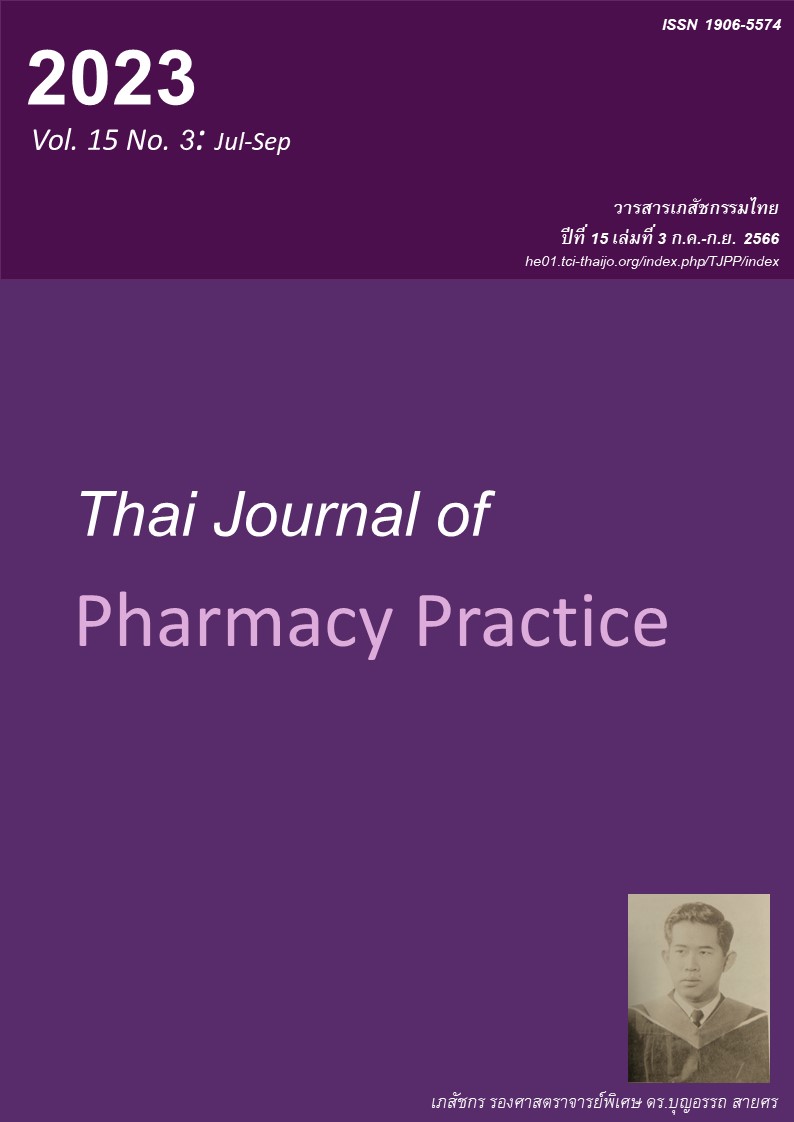การพัฒนาและประเมินผลของแนวทางการจัดการภาวะเม็ดเลือดขาวนิวโทรฟิลต่ำร่วมกับ มีไข้ในผู้ป่วยมะเร็งชนิดก้อนที่ได้รับยาเคมีบำบัด ณ โรงพยาบาลประจำจังหวัดแห่งหนึ่ง
Main Article Content
บทคัดย่อ
วัตถุประสงค์: เพื่อพัฒนาแนวทางการจัดการภาวะเม็ดเลือดขาวนิวโทรฟิลต่ำร่วมกับมีไข้ (febrile neutropenia: FN) ในผู้ป่วยมะเร็งชนิดก้อนที่ได้รับยาเคมีบำบัด วิธีการ: งานวิจัยนี้นำแนวคิดการพัฒนาคุณภาพ Plan-Do-Check-Act (PDCA) มาประยุกต์ใช้ร่วมกับการสนทนากลุ่มในสหสาขาวิชาชีพที่เกี่ยวข้อง การศึกษาประกอบด้วย 4 ระยะ ระยะที่ 1 การวางแผนและออกแบบระบบ ระยะนี้เป็นการศึกษาสถานการณ์ภาวะ FN ในผู้ป่วยมะเร็งชนิดก้อนที่ได้รับยาเคมีบำบัด โดยเก็บข้อมูลจากฐานข้อมูลอิเล็กทรอนิกส์นำไปสู่การสนทนากลุ่มเพื่อพัฒนาแนวทางการจัดการภาวะ FN ระยะที่ 2 การปฏิบัติตามระบบ เป็นการนำแนวทางการจัดการที่พัฒนาขึ้นไปทดลองใช้และปรับปรุง ระยะที่ 3 การประเมินผล เปรียบเทียบการเกิดภาวะ FN ก่อนและหลังใช้แนวทางการจัดการเป็นระยะ 3 เดือน ระยะที่ 4 การให้ข้อเสนอแนะ ผลการศึกษา: ผู้ป่วยที่เกิดภาวะเม็ดเลือดขาวนิวโทรฟิลต่ำได้รับการป้องกันและเฝ้าระวังที่แตกต่างกัน เนื่องจากยังไม่มีแนวปฏิบัติที่ชัดเจนของหน่วยงาน สหสาขาวิชาชีพที่เกี่ยวข้องจึงร่วมกันกำหนดแนวทางการจัดการ ประกอบด้วย 1) การประเมินความเสี่ยง: ประเมินจากระดับ absolute neutrophil count (ANC) 2) การป้องกัน: ผู้ป่วยที่มีความเสี่ยงพิจารณาให้ยา granulocyte colony stimulating factor (G-CSF) และ 3) การเฝ้าระวัง: ผู้ป่วยที่มีความเสี่ยงสูงควรเฝ้าระวังในโรงพยาบาลร่วมกับควรได้รับยา G-CSF หลังการนำแนวทางการจัดการไปใช้พบการเกิดภาวะ FN ลดลงจากร้อยละ 3.2 เป็นร้อยละ 0.9 (P=0.34) และพบผู้ป่วยที่มีความเสี่ยงบางคนไม่ได้รับยา G-CSF เพื่อป้องกัน นำไปสู่ข้อเสนอแนะให้ปรับปรุงขั้นตอนการทำงานและเพิ่มเกณฑ์การประเมินความเสี่ยงให้ครอบคลุมมากขึ้น สรุป: การนำแนวคิดการพัฒนาคุณภาพ PDCA มาประยุกต์ใช้ในการวิเคราะห์และแก้ไขปัญหา ทำให้ได้แนวทางการจัดการที่มีประสิทธิภาพเป็นที่ยอมรับของผู้ปฏิบัติงานมาใช้ประเมินความเสี่ยง ให้ยา G-CSF เพื่อป้องกันและเฝ้าระวังอย่างเป็นระบบ
Article Details

อนุญาตภายใต้เงื่อนไข Creative Commons Attribution-NonCommercial-NoDerivatives 4.0 International License.
ผลการวิจัยและความคิดเห็นที่ปรากฏในบทความถือเป็นความคิดเห็นและอยู่ในความรับผิดชอบของผู้นิพนธ์ มิใช่ความเห็นหรือความรับผิดชอบของกองบรรณาธิการ หรือคณะเภสัชศาสตร์ มหาวิทยาลัยสงขลานครินทร์ ทั้งนี้ไม่รวมความผิดพลาดอันเกิดจากการพิมพ์ บทความที่ได้รับการเผยแพร่โดยวารสารเภสัชกรรมไทยถือเป็นสิทธิ์ของวารสารฯ
เอกสารอ้างอิง
World Health Organization. Cancer [online]. 2022 [cited Jan 2, 2022]. Available from: www.who.int/new s-room/fact-sheets/detail/cancer.
Ministry of Public Health, Strategy and Planning Division. Public health statistics A.D.2020. Nontha buri: Ministry of Public Health; 2021.
Hashiguchi Y, Kasai M, Fukuda T, Ichimura T, Yasui T, Sumi T. Chemotherapy-induced neutropenia and febrile neutropenia in patients with gynecologic malignancy. Anticancer Drugs. 2015; 26: 1054-60.
Newburger PE, Dale DC. Evaluation and manage ment of patients with isolated neutropenia. Semin hemato. 2013; 50: 198-206.
Crawford J, Dale DC, Lyman GH. Chemotherapy induced neutropenia: Risks, consequences, and new directions for its management. Cancer. 2005; 100: 228-37.
Gupta A. Management of chemotherapy induced neutropenia – an unmet clinical need. Am J Biomed Sci 2019; 4: 313-8.
Cameron D. Management of chemotherapy-asso ciated febrile neutropenia. Br J Cancer. 2009; 101: S18-S22.
Carmona-Bayonas A, Jimenez-Fonseca P, Virizuela Echaburu J, Antonio M, Font C, Biosca M, et al. Prediction of serious complications in patients with seemingly stable febrile neutropenia: Validation of the clinical index of stable febrile neutropenia in a prospective cohort of patients from the finite study. J Clin Oncol. 2015; 33: 465-71.
The National Comprehensive Cancer Network. Hematopoietic growth factor (version 2.2019) [online]. 2019 [cited Aug 10, 2019]. Available from: www.nccn.org/professionals/physician_gls/pdf/growthfactors.pdf.
Aras E, Bayraktar-Ekincioglu A, Kilickap S. Risk assessment of febrile neutropenia and evaluation of G-CSF use in patients with cancer: a real-life study. Support Care Cancer 2020; 28: 691-9.
Edelsberg J, Weycker D, Bensink M, Bowers C, Lyman GH. Prophylaxis of febrile neutropenia with colony-stimulating factors: the first 25 years. Curr Med Res Opin. 2020; 36: 483-95.
Taylor MJ, McNicholas C, Nicolay C, Darzi A, Bell D, Reed JE. Systematic review of the application of the plan-do-study-act method to improve quality in healthcare. BMJ Qual Saf. 2014; 23: 290-8.
National Cancer Institute. Common terminology criteria for adverse events (CTCAE) (version 5.0) [online]. 2017 [cited Oct 27, 2021]. Available from: ctep.cancer.gov/protocoldevelopment/electronic_applications/docs/CTCAE_v5_Quick_Reference_5x7.pdf.
Aapro MS, Bohlius J, Cameron DA, Dal Lago L, Donnelly JP, Kearney N, et al. 2010 Update of EORTC guidelines for the use of granulocyte colony stimulating factor to reduce the incidence of chemotherapy induced febrile neutropenia in adult patients with lymphoproliferative disorders and solid tumours. Eur J Cancer. 2011; 47: 8-32.
Cooper KL, Madan J, Whyte S, Stevenson MD, Akehurst RL. Granulocyte colony-stimulating factors for febrile neutropenia prophylaxis following chemo therapy: Systematic review and meta-analysis. BMC Cancer. 2011; 11: 404.
Kasi PM, Grothey A. Chemotherapy induced neutro penia as a prognostic and predictive marker of outcomes in solid-tumor patients. Drugs. 2018; 78: 737-45.
Pruaksoranan D, Anejirawattana S. Improving efficiency of operating rooms utilization during official hours in Chonburi hospital. Journal of Public Health Nursing. 2017; 31: 165-81.
Smith TJ, Bohlke K, Lyman GH, Carson KR, Crawford J, Cross SJ, et al. Recommendations for the use of WBC growth factors: American society of clinical oncology clinical practice guideline update. J Clin Oncol. 2015; 33: 3199-212.


